Mid-winter has passed and farmers are preparing for the marathon that is the spring calving season to hit them.
A lot of work has been done to promote a compact calving season among dairy and beef farmers, with dairy farmers in particular looking to match peak milk yield with peak grass growth and maximise days in milk within their herd.
Few farmers who have tightened up on their calving spread with improved fertility and more severe culling would revert back to months of calving. The organised chaos of calving most cows in the first month means farmers are focused on calving 24/7.
However, with such a volume of cows calving in such a short space of time, facilities need to be in place to safely allow all of these cows to calve.
Otherwise, the pain of a lack of sleep will be replaced with a much greater pain of an increased vet bill and high mortality rates.
As herd sizes have increased, particularly on dairy farms, many farmers have opted for group calving over individual pens. In general, group calving results in less labour as there is only one large area to keep clean and bedded, as opposed to several small pens that may have to be manually cleaned out due to poor access.
A group pen will also allow for cows to be fed together along a barrier or in a ring feeder, as opposed to having to feed individual cows in separate pens.
A group calving area does not need to be a purpose-built shed. Machinery stores or hay sheds can function perfectly fine. As long as there is adequate ventilation in place, there is access for bedding and cleaning out with a tractor or telehandler and that there are facilities for the collection of effluent.
Often, a dry shed attached to a slatted shed can be utilised, with a doorway cut into a wall to allow cows access between the slatted and dry areas.
The slatted area can then be used as the feed area to help reduce bedding use.
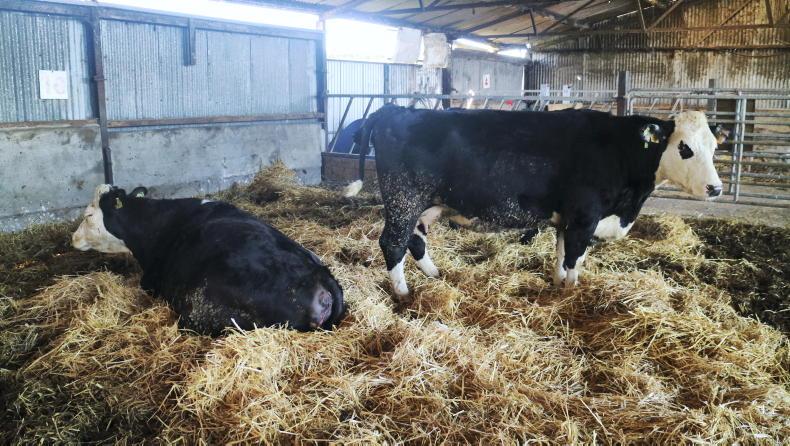
Communal or group calving areas have been used on suckler herds such as the Newford (pictured) and Tullamore Farm.
Some farmers, in putting up new cubicle sheds, have purposely created these areas where cows can be drafted from the main cubicle area to a calving area where there is a bedded lieback, a feed area and a small number of cubicles.
Reports from farmers indicate that this is reducing the need for bedding but still resulting in cows calving in the dry bedded area.
However, groups pens are not the silver bullet to reducing labour. Major headaches can be caused with mismothering, especially in suckler cows that tend to have greater mothering instincts.
Cows and calves need to be removed to individual pens for suckler pairs to allow a bonding period, before moving to smaller pods of freshly calved cows.
In dairy herds, the issue arises where two or more cows calve at the same and calves are registered to the wrong dams.
Group calving can also run the risk of Johne’s spreading through calves suckling from cows other than their dams. The best-case scenario for many farms is to create some individual pens beside the group calving area.
The main issue with individual pens is the amount of labour they create; feeding, bedding and cleaning out takes significantly longer than for a group area.
However, they are often the best option for suckler herds to allow for bonding to take place. Each individual pen should have its own supply of clean, fresh water and access to a calving gate to assist in difficult calvings or to allow a cow to be restrained for treatment or to allow a calf to suckle.
Individual pens should be accessible to a tractor/loader for cleaning out. Ideally, independent access to each pen should be available for cleaning out.
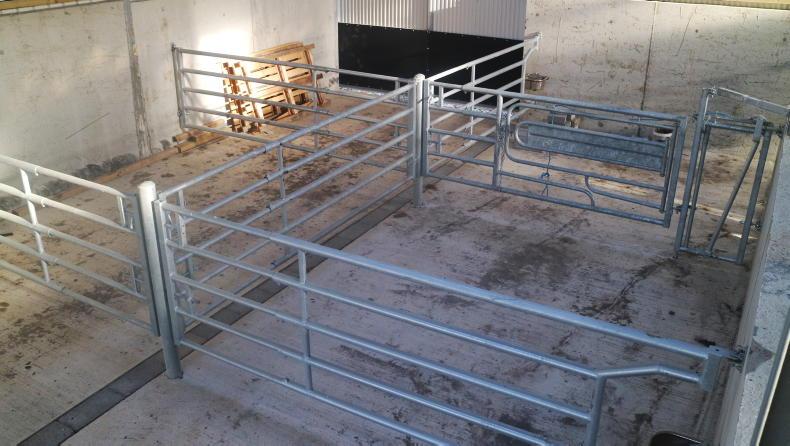
Four individual calving pens were installed beside a group calving, with a calving gate between two of these on this Tipperary farm.
This is one of the major drawbacks to individual calving boxes, in that they are difficult to clean out and are often just limed and rebedded in between cows.
Costly
Individual penning is also costly to install, and permanent penning prevents the shed being used for other purposes in between calving periods. Therefore, as mentioned previously, using a mix of group and individual calving pens are the best option for many farmers.
Requirements of calving areas
As mentioned, access with a tractor and loader is one of key needs of a calving area. Ample access to water, preferably in a tip-out trough for ease of cleaning, should also be available. Good lighting should be fitted for night-time work.
While many calving cameras have infrared lighting to allow them to be used in the dark, the picture quality from a well-lit area is far superior.
As with all animal housing, ventilation is critical, with the difficult part being to create adequate ventilation without creating draughts.
Space sheeting, ridge gaps, Yorkshire boarding and wind breakers are all ways of creating air inlets, with a suitable outlet also required. Open doorways, as a rule of thumb, are a poor means of air inlets as they are an unregulated air flow and often create draughts.
Floors should be concrete to allow for ease of cleaning and allow for the channelling of effluent. A one-in-30 or one-in-40 slope should be created, with a 75mm x 75mm channel fitted to take the effluent away to appropriate storage.
Cows will require approximately 10m2 per cow in a dry-bedded calving area. This can be lessened slightly where cows have access to a slatted or scraped feed area.
A man escape should be fitted to allow a farmer to escape in a case of a cow attack. Herds will require enough calving space for approximately 10% of the herd at any one time, increasing or decreasing depending on the herd’s six-week calving rate.
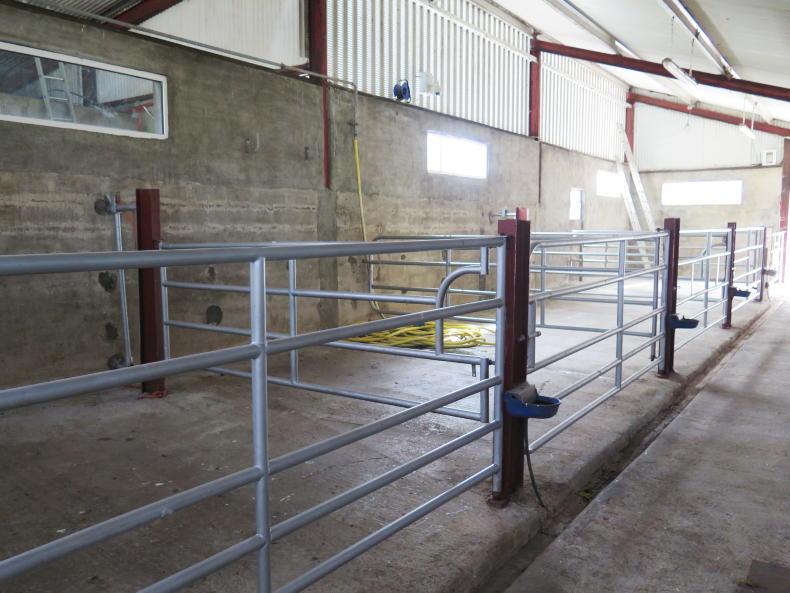
Individual calving pens. Note the effluent channel at the front of each pen.
Straw remains the most common type of bedding used for calving areas due to its availability.
Barley straw tends to have the highest level of soakage but comes at a premium price over oaten or wheaten straw. Rape straw is another option farmers have looked towards, but its abrasive nature lends to it being used as an underbed, being topped up after by barley straw.
Dry matter and chop length of straw will affect its absorption ability; indeed, chopping straw has become popular as a means of improving absorption and reducing bedding requirements.
Where a straw chopper is not available, a diet feeder will chop straw comparably well, although there is labour involved in scattering it across the pen after.
Milled peat, a once popular option due to its reduced labour requirements, has become both difficult to source and is environmentally unsustainable.
Timber-based bedding such as sawdust and woodchip offer reduced workload compared to straw due to their high absorption rate, although pose issues as they have to be composted for several years after use or ploughed in.
Where timber products are used, care must be taken that they have not been treated with preservatives that may prove poisonous to animals.
Mid-winter has passed and farmers are preparing for the marathon that is the spring calving season to hit them.
A lot of work has been done to promote a compact calving season among dairy and beef farmers, with dairy farmers in particular looking to match peak milk yield with peak grass growth and maximise days in milk within their herd.
Few farmers who have tightened up on their calving spread with improved fertility and more severe culling would revert back to months of calving. The organised chaos of calving most cows in the first month means farmers are focused on calving 24/7.
However, with such a volume of cows calving in such a short space of time, facilities need to be in place to safely allow all of these cows to calve.
Otherwise, the pain of a lack of sleep will be replaced with a much greater pain of an increased vet bill and high mortality rates.
As herd sizes have increased, particularly on dairy farms, many farmers have opted for group calving over individual pens. In general, group calving results in less labour as there is only one large area to keep clean and bedded, as opposed to several small pens that may have to be manually cleaned out due to poor access.
A group pen will also allow for cows to be fed together along a barrier or in a ring feeder, as opposed to having to feed individual cows in separate pens.
A group calving area does not need to be a purpose-built shed. Machinery stores or hay sheds can function perfectly fine. As long as there is adequate ventilation in place, there is access for bedding and cleaning out with a tractor or telehandler and that there are facilities for the collection of effluent.
Often, a dry shed attached to a slatted shed can be utilised, with a doorway cut into a wall to allow cows access between the slatted and dry areas.
The slatted area can then be used as the feed area to help reduce bedding use.

Communal or group calving areas have been used on suckler herds such as the Newford (pictured) and Tullamore Farm.
Some farmers, in putting up new cubicle sheds, have purposely created these areas where cows can be drafted from the main cubicle area to a calving area where there is a bedded lieback, a feed area and a small number of cubicles.
Reports from farmers indicate that this is reducing the need for bedding but still resulting in cows calving in the dry bedded area.
However, groups pens are not the silver bullet to reducing labour. Major headaches can be caused with mismothering, especially in suckler cows that tend to have greater mothering instincts.
Cows and calves need to be removed to individual pens for suckler pairs to allow a bonding period, before moving to smaller pods of freshly calved cows.
In dairy herds, the issue arises where two or more cows calve at the same and calves are registered to the wrong dams.
Group calving can also run the risk of Johne’s spreading through calves suckling from cows other than their dams. The best-case scenario for many farms is to create some individual pens beside the group calving area.
The main issue with individual pens is the amount of labour they create; feeding, bedding and cleaning out takes significantly longer than for a group area.
However, they are often the best option for suckler herds to allow for bonding to take place. Each individual pen should have its own supply of clean, fresh water and access to a calving gate to assist in difficult calvings or to allow a cow to be restrained for treatment or to allow a calf to suckle.
Individual pens should be accessible to a tractor/loader for cleaning out. Ideally, independent access to each pen should be available for cleaning out.

Four individual calving pens were installed beside a group calving, with a calving gate between two of these on this Tipperary farm.
This is one of the major drawbacks to individual calving boxes, in that they are difficult to clean out and are often just limed and rebedded in between cows.
Costly
Individual penning is also costly to install, and permanent penning prevents the shed being used for other purposes in between calving periods. Therefore, as mentioned previously, using a mix of group and individual calving pens are the best option for many farmers.
Requirements of calving areas
As mentioned, access with a tractor and loader is one of key needs of a calving area. Ample access to water, preferably in a tip-out trough for ease of cleaning, should also be available. Good lighting should be fitted for night-time work.
While many calving cameras have infrared lighting to allow them to be used in the dark, the picture quality from a well-lit area is far superior.
As with all animal housing, ventilation is critical, with the difficult part being to create adequate ventilation without creating draughts.
Space sheeting, ridge gaps, Yorkshire boarding and wind breakers are all ways of creating air inlets, with a suitable outlet also required. Open doorways, as a rule of thumb, are a poor means of air inlets as they are an unregulated air flow and often create draughts.
Floors should be concrete to allow for ease of cleaning and allow for the channelling of effluent. A one-in-30 or one-in-40 slope should be created, with a 75mm x 75mm channel fitted to take the effluent away to appropriate storage.
Cows will require approximately 10m2 per cow in a dry-bedded calving area. This can be lessened slightly where cows have access to a slatted or scraped feed area.
A man escape should be fitted to allow a farmer to escape in a case of a cow attack. Herds will require enough calving space for approximately 10% of the herd at any one time, increasing or decreasing depending on the herd’s six-week calving rate.

Individual calving pens. Note the effluent channel at the front of each pen.
Straw remains the most common type of bedding used for calving areas due to its availability.
Barley straw tends to have the highest level of soakage but comes at a premium price over oaten or wheaten straw. Rape straw is another option farmers have looked towards, but its abrasive nature lends to it being used as an underbed, being topped up after by barley straw.
Dry matter and chop length of straw will affect its absorption ability; indeed, chopping straw has become popular as a means of improving absorption and reducing bedding requirements.
Where a straw chopper is not available, a diet feeder will chop straw comparably well, although there is labour involved in scattering it across the pen after.
Milled peat, a once popular option due to its reduced labour requirements, has become both difficult to source and is environmentally unsustainable.
Timber-based bedding such as sawdust and woodchip offer reduced workload compared to straw due to their high absorption rate, although pose issues as they have to be composted for several years after use or ploughed in.
Where timber products are used, care must be taken that they have not been treated with preservatives that may prove poisonous to animals.







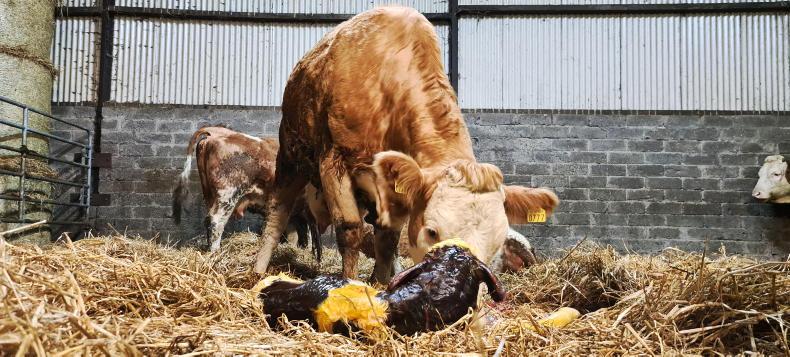
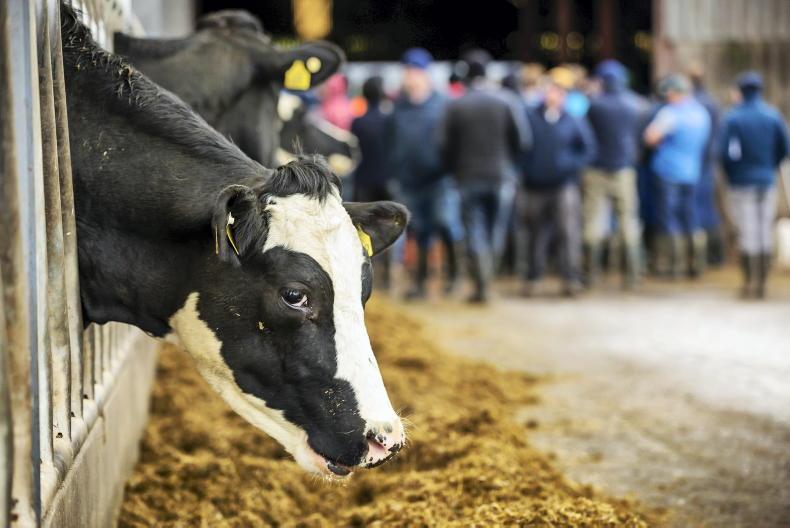


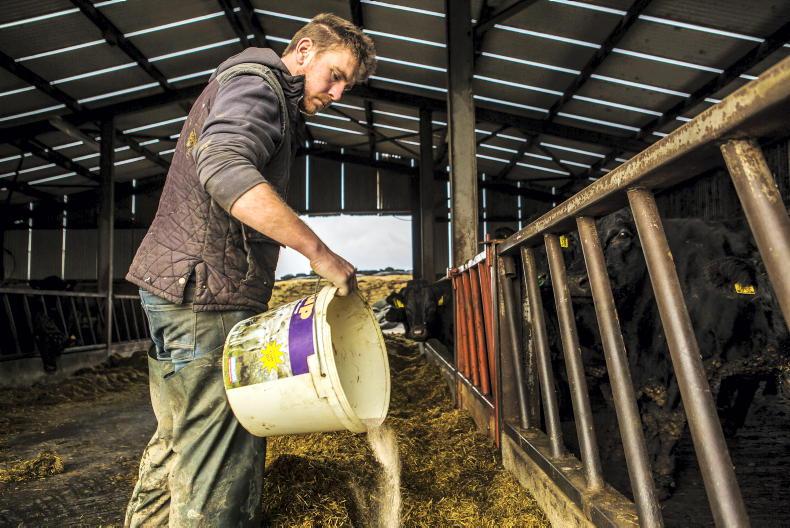
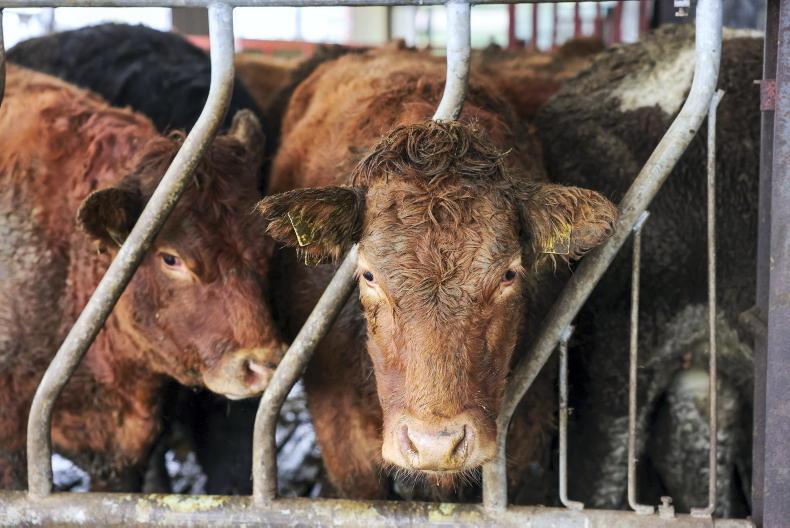
SHARING OPTIONS